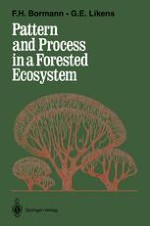1994 | OriginalPaper | Buchkapitel
The Steady State as a Component of the Landscape
verfasst von : F. Herbert Bormann, Gene E. Likens
Erschienen in: Pattern and Process in a Forested Ecosystem
Verlag: Springer New York
Enthalten in: Professional Book Archive
Aktivieren Sie unsere intelligente Suche, um passende Fachinhalte oder Patente zu finden.
Wählen Sie Textabschnitte aus um mit Künstlicher Intelligenz passenden Patente zu finden. powered by
Markieren Sie Textabschnitte, um KI-gestützt weitere passende Inhalte zu finden. powered by
Models of ecosystem development usually portray autogenic succession as an orderly progression of biologic changes (e.g., Odum, 1969; Woodwell, 1974). The macroenvironment within which development occurs is presumed to be more or less constant throughout the autogenic sequence. Yet every terrestrial ecosystem is subjected to a range of disturbances varying from those that barely alter the structure, metabolism, or biogeochemistry of the ecosystem to those that wholly or dramatically change the system. Defining “disturbance” is itself a considerable problem, because it is difficult to draw a line between biological and physical-chemical events that may be considered within the scope of autogenic development and other events that might be considered to seriously deflect the autogenic pattern. In developing the Hubbard Brook Biomass Accumulation Model (Chapter 1) of ecosystem development, we followed the procedures of Odum (1969), Botkin et al. (1972a,b), and Woodwell (1974) and emphasized autogenic development, while deemphasizing exogenous disturbance. This was a necessary decision if our model was to reflect an uninterrupted sequence from the initiation of secondary development to the establishment of the steady state.
